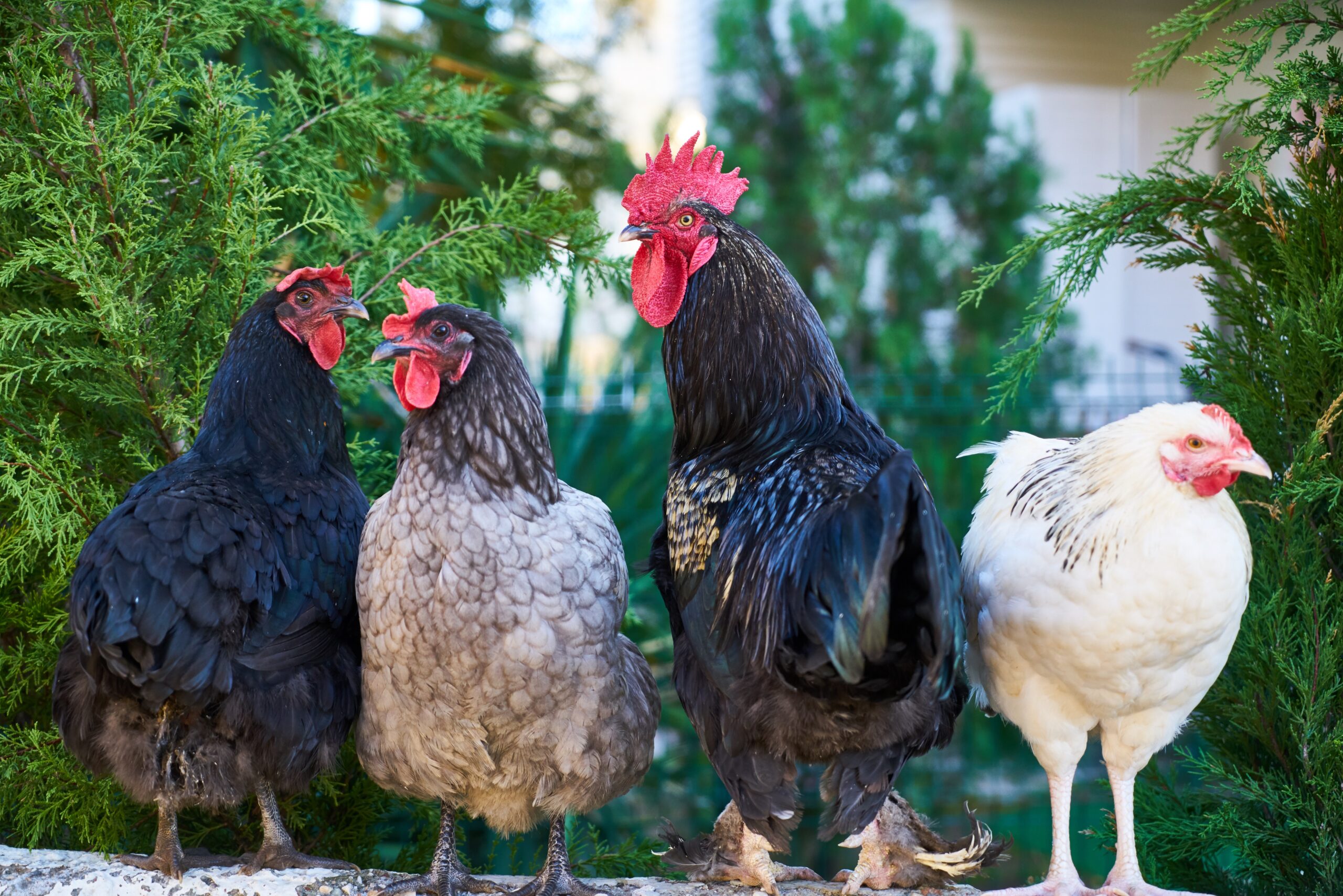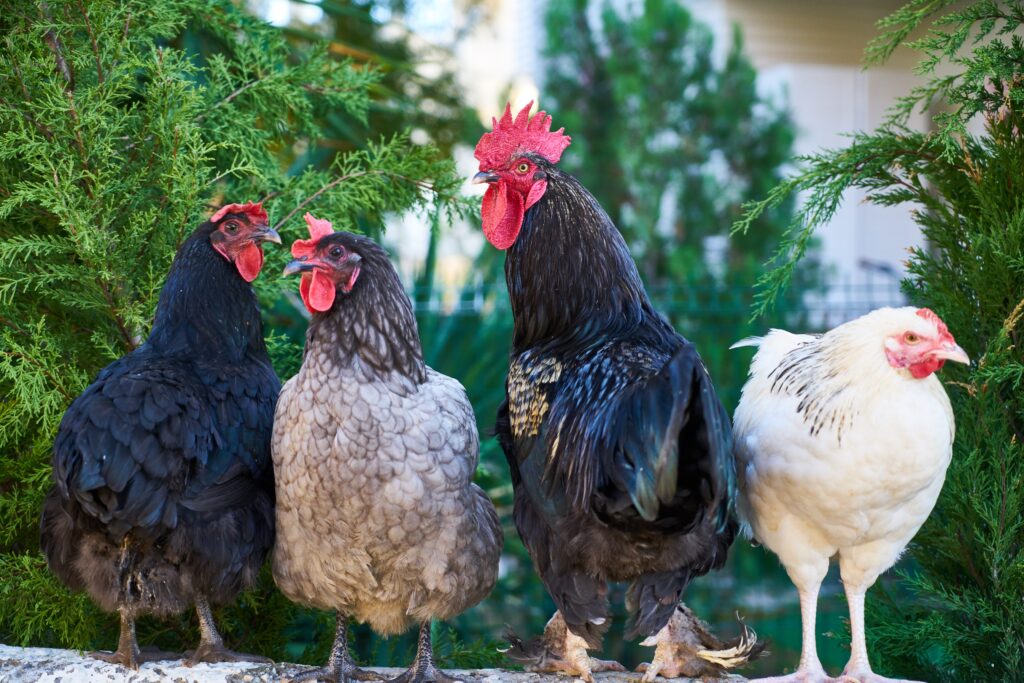
Chickens have memory, emotions, empathy and a keenly developed consciousness of one another and their surroundings. They deserve our respect and care.
(Photo credit: Engin Akyurt/Pexels)
By Karen Davis, Independent Media Institute


Most people I talk to are surprised to learn that chickens evolved in a rugged, tropical forest habitat filled with vibrant colors and sounds to which they contribute their share to this day. Many are surprised to learn that chickens are endowed with memory and emotions and a keenly developed consciousness of one another and their surroundings.
A newspaper reporter who visited our sanctuary was astonished to discover that chickens recognize each other as individuals after they’ve been separated. A friend and I had rescued a hen and a rooster in a patch of woods alongside a road in rural Virginia. The first night we managed to get the hen out of the tree, but the rooster got away. The next night after hours of playing hide and seek with him in the rain, we managed to snag the rooster, and the two reunited at our sanctuary. When the reporter visited a few days later, she saw these two chickens, Lois and Lambrusco, foraging together as a couple, showing that they remembered each other after being apart.
Chickens form memories that influence their social behavior from the time they are embryos, and they update their memories over the course of their lives. I’ve observed their memories in action at our sanctuary many times. For instance, if I have to remove a hen from the flock for two or three weeks in order to treat an infection, when I put her outside again, she moves easily back into the flock — they accept her as if she had never been away. There may be a little showdown, a tiff instigated by another hen, but the challenge is quickly resolved. Best of all, I’ve watched many a returning hen greeted by her own flock members led by the rooster walking over and gathering around her conversably.
The purpose of our sanctuary in Virginia is to provide a place for chickens who need a home, rather than adding to the population and thus diminishing our capacity to adopt more birds. For this reason, we do not allow our hens to hatch their eggs as they would otherwise do, given their association with the roosters in our yard. All of our birds have been adopted from situations of abandonment or abuse, or else they were no longer wanted or able to be cared for by their previous owners. Our two-acre sanctuary is a predator-proof yard with the wooded areas and soil chickens love to perch and scratch in all year round.
I broke our no chick-hatching rule on one occasion. Returning from a trip, I discovered that Daffodil, a soft white hen with a sweet face and quiet manner, was nestled deep in the corner of her house in a nest she’d pulled together from the straw bedding on the dirt floor. Seeing there were only two eggs beneath her, I left her alone. Not long after on a day in June, while scattering fresh straw in her house, I heard the tiniest peeps. Thinking a sparrow was caught inside, I looked to guide the bird out, but those peeps were not from a sparrow: They arose from Daffodil’s corner. Peering into the dark place where she sat, I beheld a little yellow face with dark bright eyes peeking out of her feathers.
I knelt down and stared into the face of this tiny chick who looked intently back at me before hiding himself and peeking out again. I looked into Daffodil’s face as well, knowing from experience that making direct eye contact with chickens is crucial to forming an affectionate bond with them.
From the first, a large red rooster named Francis visited Daffodil and her chick in their nesting place, and Daffodil acted happy and content to have him there. Frequently, I found him sitting quietly with her and the little chick, who scrambled around both of them, in and out of their feathers. Though roosters will mate with more than one hen in the flock, a rooster and hen may also form bonds so strong that they will not mate with anyone else.
Could it be that Francis was the father of this chick and that he and Daffodil knew it? He certainly was uniquely and intimately involved with the pair, and it wasn’t as though he was the head of the flock, the one who oversaw all of the hens and the other roosters and was thus fulfilling his duty in that role. Rather, Francis seemed simply to be a member of this particular family.
For the rest of the summer, Daffodil and her chick formed a kind of enchanted circle with an inviolable space all around themselves, as they roamed together in the yard, undisturbed by the other chickens. Not once did I see Francis or any of the other roosters try to mate with Daffodil during the time she was raising her frisky chick — the little one I named Daisy who grew up to be Sir Daisy, a large, handsome rooster with white and golden-brown feathers.

When I first started keeping chickens, there were no predators, until a fox found us. We built our fences after eleven chickens disappeared rapidly under our nose. The fox would sneak up in broad daylight, raising a clamor among the birds. Running outside I’d see no stalker, just sometimes a soul-stabbing bunch of feathers on the ground at the site of abduction. When our bantam rooster Josie was taken, his companion Alexandra ran shrieking through the kitchen, jumped up on a table, still shrieking, and was never the same afterward.
It was too much. I sat on the kitchen floor crying and screaming. At the time, I was caring for Sonja, a big white warm-natured, bouncy hen I was treating for wounds she’d received before I rescued her. As I sat on the floor exploding with grief and guilt, Sonja walked over to where I sat weeping. She nestled her face next to mine and began purring with the ineffable soft purr that is also a trill in chickens. She comforted me even as her gesture deepened the heartache I was feeling. Did Sonja know why I was crying? I doubt it, but maybe she did. Did she know I was terribly sad and distressed? There is no question about that. She responded to my grief with an expression of empathy that I have carried emotionally in my life ever since.
I do not seek to sentimentalize chickens but to characterize them as best I can, based on my observations and relationships with them over many years. In the 1980s, I discovered a crippled chicken named Viva all alone in a shed. My experience with her led me to found United Poultry Concerns in 1990. Little did I know as I lifted her out of the shed to take her home with me that it was the first day of the rest of my life advocating for chickens and their rights.
May 4 is International Respect for Chickens Day and May is International Respect for Chickens Month. We urge people who care about animals to do a positive action for chickens that illuminates who they are and how we can help them.
###
Karen Davis, Ph.D., is the president and founder of United Poultry Concerns, a nonprofit organization that promotes the compassionate and respectful treatment of domestic fowl including a sanctuary for chickens in Virginia. Inducted into the National Animal Rights Hall of Fame for Outstanding Contributions to Animal Liberation, Karen is the author of Prisoned Chickens, Poisoned Eggs: An Inside Look at the Modern Poultry Industry; More Than a Meal: The Turkey in History, Myth, Ritual, and Reality; The Holocaust and the Henmaid’s Tale: A Case for Comparing Atrocities and other works including her children’s book A Home for Henny and Instead of Chicken, Instead of Turkey: A Poultryless “Poultry” Potpourri, a vegan cookbook. A volume of Karen’s writings, For the Birds – From Exploitation to Liberation: Essays on Chickens, Turkeys, and Other Domestic Fowl, will be published in 2019 by Lantern Books.
This article was produced by Earth | Food | Life, a project of the Independent Media Institute.
Earth | Food | Life (EFL) explores the critical and often interconnected issues facing the climate/environment, food/agriculture and animal/nature rights, and champions action; specifically, how responsible citizens, voters and consumers can help put society on an ethical path of sustainability that respects the rights of all species who call this planet home. EFL emphasizes the idea that everything is connected, so every decision matters.
Click here to support the work of EFL and the Independent Media Institute.
Questions, comments, suggestions, submissions? Contact EFL editor Reynard Loki at [email protected]. Follow EFL on Twitter @EarthFoodLife.
